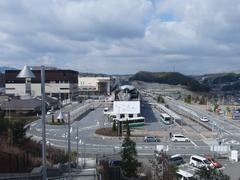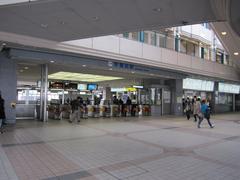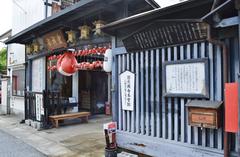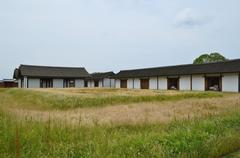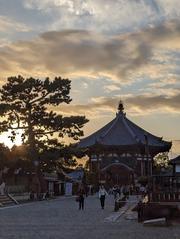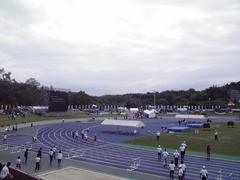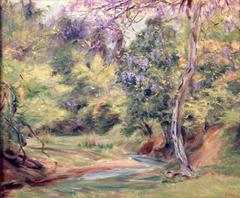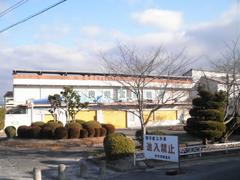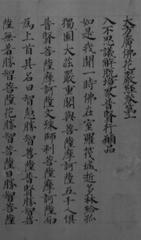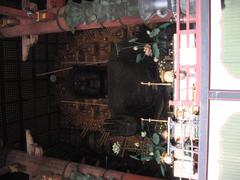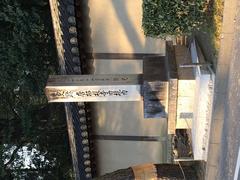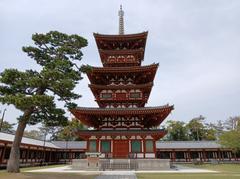Nara Crafts Museum: Visiting Hours, Tickets, and Guide to Nara Historical Sites
Date: 14/06/2025
Introduction
The Nara Crafts Museum stands as a vibrant testament to more than 1,300 years of Japanese craftsmanship and artistic heritage. Located in the heart of Nara, Japan’s first permanent capital, the museum provides an immersive journey into the evolution and living traditions of ceramics, textiles, lacquerware, metalwork, and woodcraft. Whether you are a history enthusiast, a curious traveler, or a family seeking cultural enrichment, this comprehensive guide presents everything you need to plan your visit—from practical details on visiting hours and tickets to insights into the region’s artisan legacy and nearby historical sites.
Historical Background and Cultural Significance
Roots in the Ancient Capital
Nara’s significance as a cultural and artistic center began in 710 CE, when it became Japan’s first permanent capital. The city flourished as a hub for the exchange of ideas, materials, and techniques, thanks to its position at the end of the Silk Road. Foreign influences were skillfully blended with local traditions, giving rise to uniquely Japanese crafts (Nara Crafts Museum; Visit Nara).
The Silk Road and Imperial Patronage
The Silk Road was instrumental in introducing new technologies and aesthetics to Nara. Imperial support fostered the development of crafts for religious, courtly, and everyday use. Temples like Tōdaiji and Kōfukuji drove demand for sophisticated statuary, lacquerware, and ritual implements, while the Shōsōin Treasure House remains a repository of Silk Road treasures that continue to inspire artisans (Facts and Details).
A Living Legacy
Even after the capital moved to Kyoto, Nara maintained its cultural prominence. Techniques such as Nara sumi ink-making and narazarashi hemp weaving have been preserved and passed down through generations, with family-run workshops still active today. Seasonal rituals, religious ceremonies, and courtly traditions have ensured the continuity and evolution of these crafts (Visit Nara).
Practical Visitor Information
Location and Access
The Nara Crafts Museum is conveniently located in the Naramachi district—a historic area known for its preserved merchant townhouses and atmospheric lanes. The museum can be reached:
- On Foot: 10–20 minutes from Kintetsu Nara Station or JR Nara Station
- By Bus: Nara Loop Bus stops near Naramachi
- By Car: Limited parking available (4 spaces, including 1 for disabled visitors)
- Address: 1-1 Azemamecho, Nara City, Nara Prefecture, 630-8346, Japan (Nara Crafts Museum Access)
Visiting Hours
- Open: 10:00 AM – 6:00 PM (last admission 5:30 PM)
- Closed: Mondays (or the next day if Monday is a holiday), December 26 – January 5, and during exhibition changeovers
- Note: Hours may vary for special events; check the official website for updates.
Ticket Prices
- Admission: Free of charge; no advance reservation or ticket required
- Workshops: Some require a fee and advance booking
Accessibility
- Wheelchair accessible throughout the building
- Elevator access to all floors
- Barrier-free restrooms
- Wheelchair rental available
- Priority parking for visitors with disabilities (Nara Crafts Museum Barrier-Free)
Facilities
- Restrooms
- Gift shop featuring locally crafted souvenirs
- Lockers for small belongings
- Workshop rooms for hands-on craft experiences
Museum Highlights
Permanent and Special Exhibitions
The museum’s permanent collection features exemplary works from local and regional artisans, including:
- Ceramics: Akahada-yaki pottery and Nara-yaki for tea ceremonies
- Textiles: Narazarashi hemp cloth, kasuri (ikat), shibori (tie-dye)
- Lacquerware: Nara shikki, integral to religious ceremonies
- Metalwork: Buddhist ritual implements, sword fittings
- Woodcraft and Bamboo: Baskets, furniture, and Nara-ningyo dolls
Special exhibitions and artist showcases are regularly held in Gallery Azemame, ensuring there is always something new to discover (Nara Crafts Museum Facility Summary).
Interactive Workshops
Visitors are encouraged to participate in workshops on pottery, indigo dyeing, brush-making, and more. These are suitable for all ages and skill levels, with some sessions offering English support (Nara Crafts Museum Workshops).
Multilingual Support
- Most signage in Japanese; selected materials and workshop instructions available in English
- Assistance available at the museum and nearby Nara Visitor Center & Inn (Nara Visitor Center & Inn)
Cultural Significance and Representative Crafts
Nara’s crafts are intertwined with local festivals, religious rituals, and seasonal traditions:
- Nara Fude (Calligraphy Brushes): Used since the Nara Period for sutra copying (Visit Nara)
- Nara Sumi (Ink Sticks): Traditionally produced at Kobaien workshop (Visit Nara)
- Akahada-yaki Pottery: Red clay ceramics used in tea ceremonies
- Narazarashi (Hemp Cloth): Finely woven for monks’ robes
- Ittobori (One-Knife Carving): Wooden festival figures
- Nara Shikki (Lacquerware): Used in the annual Omizutori Ceremony at Tōdaiji (Nara Crafts Museum)
These crafts continue to shape Nara’s regional identity and economy, with many recognized as Important Cultural Properties or produced by Living National Treasures (GLTJP).
Nearby Historical Sites and Attractions
- Naramachi District: Edo-period townhouses, artisan shops, and atmospheric streets
- Gangoji Temple: UNESCO World Heritage Site, Japan’s first Buddhist temple
- Nara Park: Famous for its free-roaming deer and proximity to major temples
- Todaiji Temple: Home to the Great Buddha Hall, a UNESCO site
- Kofukuji Temple: Five-story pagoda and Buddhist art collection
- Kasuga Taisha Shrine: Renowned for stone and bronze lanterns
- Nara National Museum: Extensive Buddhist art exhibits (Nara National Museum Hours)
- Isuien Garden: Tranquil pond gardens and traditional teahouse
Travel Tips
- Best Time to Visit: Spring and autumn for mild weather and seasonal festivals
- Recommended Duration: 1–1.5 hours for the museum; plan extra time for workshops or nearby sites
- Photography: Permitted in some areas; check signage or ask staff
- Souvenirs: Support local artisans by purchasing crafts at the museum shop
- Dining: Numerous cafés and restaurants in Naramachi and near Nara Park
Special Events and Seasonal Highlights
The museum frequently hosts seasonal exhibitions, artisan demonstrations, and events that coincide with Nara’s major festivals:
- Omizutori Ceremony: March at Todaiji; features Nara lacquerware
- Nara Tokae Lantern Festival: August, with illuminated parks and temples
Free admission days may be offered during special events (Free Admission Days).
Frequently Asked Questions (FAQ)
Q: Is admission really free?
A: Yes, there is no charge for entry.
Q: Are guided tours available?
A: Occasionally; check the website or ask on arrival.
Q: Can I take photos?
A: Photography rules vary by exhibition. Look for signage or ask staff.
Q: Is the museum accessible?
A: Yes, the building is barrier-free with elevator and accessible restrooms.
Q: Are workshops suitable for children?
A: Most workshops welcome all ages.
Conclusion
The Nara Crafts Museum is a gateway to Japan’s artistic soul—a place where history, craft, and community come alive. With its accessible location, free admission, and ever-changing exhibitions and workshops, it is a must-visit for anyone seeking to experience the essence of Nara’s cultural legacy. Enhance your trip by exploring Naramachi’s historic streets and nearby UNESCO World Heritage sites.
For up-to-date information on hours, workshops, and special events, visit the official website. Download the Audiala app for guided tours and cultural insights, and follow us on social media for the latest news and tips.
Sources
- Nara Crafts Museum
- Visit Nara
- GLTJP
- Nara National Museum Hours
- Japan Experience
- Facts and Details
- Nara Crafts Museum Information
